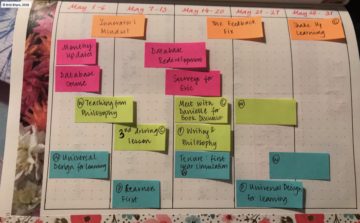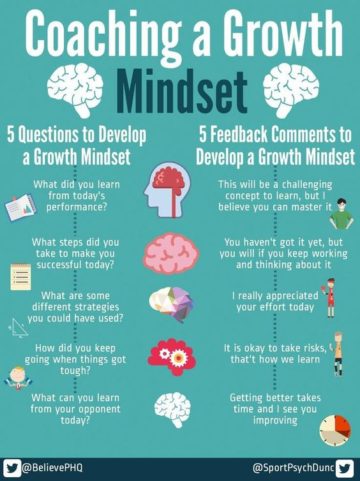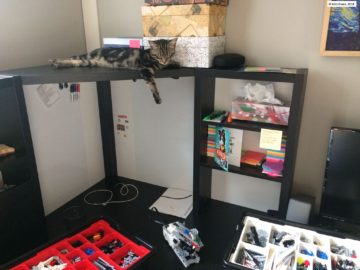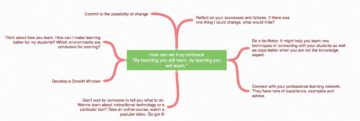By teaching you will learn, by learning you will teach. — A Latin proverb

This has been my motto since the day I fell in love with teaching. It depicts how teaching and learning go together and teachers are as much learners as their students.
In his fantastic book, From Master Teacher to Master Learner, Will Richardson recounts how he always starts his presentations and workshops with the phrase teachers as learner firstand how it often gets a significant number of tweets and comments from teachers and educators who do not see this as their role. In some ways, I understand why such a disconnect would occur — learning gets equated to taking a course or reading a textbook, while in reality we learn all the time — from our teachers, our peers, our students, and our devices too.
Will converses with the reader throughout the book, asking hard questions like “How do you learn?” and making one think about the role of education as well as technology in education. He emphasizes that for us, teachers, to teach our students best, we have to understand not only how we learn and when we learn best but also who our students are, how they learn, and what objects are an integral part of their lives. We also need to understand how to use technology as a learning tool rather than limiting it to an instructional tool for the teacher. All this involves rethinking the premises we hold about education, and unlearning and facing our biases to fit in the modern world.
Learning and Growth Mindset
One of the myths a teacher could potentially walk into the classroom with is that we are the smartest people in the room. My teaching experiences were never like that. I remember my biggest question when I was minutes away from teaching my first Computer Lab as a Teaching Assistant was “What if I don’t know the answer to their question?” I realized soon after that I did not have to know everything. I could direct them to places where my students could find answers or connect them with another student or someone else who might be able to give them better help.

We have to be fearless in reaching out to those who we know can help. This comes at the cost of giving up the impression that we know it all, and become facilitators of learning. One way we will be able to reach out to others is through a Professional Learning Network. We can connect with other teachers and educators, via Twitter and blogging, as Will suggests. My friend, Amanda, also wrote about it on her blog recently.
A fixed mindset is when we believe things are not in our hands and we cannot change the outcome while growth mindset is about lifelong learning. It was developed by Dr Carol Dweck (2006) and is about encouraging students and making them realize their potential — to find the positive in their difficult experiences and to always be open to learning and growing. Learners with growth mindset know that they do not know everything and are focused on mastery rather than performance. They understand that assessments are not a marker for their grasp of the subject, instead they represent only a snapshot of what they know. A video by Sprouts explains the difference between growth and fixed mindset very well. How Kids Work presents classroom ideas that would help in growth mindset.
I want my students to have a growth mindset but that is not possible without me developing a growth mindset myself.
According to Will, master learners have growth mindsets: they do not wait for people to tell them what to do (read this book, attend this seminar, take this course), instead, they go looking for opportunities that allow them to come in contact with new ideas and learn. They do these things by choice. A teacher as a master learner is aware and committed to the possibility of change, whether it is of technology or the curriculum, and this commitment is because of the will to learn and embrace new practices when appropriate. A master learner teacher exhibits a growth mindset. Will and his team describe the attributes of such educators here.
Modern Learning
Modern learning is self-organized; the learner creates his or her own curriculum, finds his or her own teachers and classmates and reflects on and assesses his or her work to achieve learning goals. It is based on passion and the questions that are important to the learner. Modern learning is about doing authentic work in the world, that can be amplified by technology. And it is about forming networks and communities outside the physical space to support and nurture the work. (Richardson, p. 17)
The emphasis of modern learning is on freedom, metacognition and learning goals. It aligns with the teaching philosophy of existentialism as the students decide what, how and with whom they want to learn, building an identity for themselves. The teacher is a resource to help them accomplish their goals and give them access to the further resources that they might need. This idea has guided my teaching philosophy as well.
As mentioned earlier, Professional Learning Networks are a way to do that. Just like a scientist searches for solutions, either implementing an already existing theory or discovering something on his own, we might be motivated by the lack of answers to some problems in a classroom. We continue to learn when we encounter situations that compel us to find solutions. For example, I might research how to build a safer classroom environment or teach social emotional learning if I have students with trauma in the class.
Action-Based Research
Teachers often implement action research which “is a disciplined process of inquiry conducted by and for those taking the action (teachers). The primary reason for engaging in action research is to assist the ‘actor’ (learner) in improving and/or refining his or her actions” (Sagor, 2000, Chp. 1). Action research is an iterative process that helps the teacher focus on a problem, research solutions, implement them in the class, observe and review results and redo the process with other solutions to ensure the outcome is reached. Thus, learning does not end when we graduate from our teaching programs and become certified teachers.
However, rather than addressing only problems, teachers become true learners when we keep up with the advances in the world and are connected with our peers, learning from their successes and mistakes, as well as our own. When we start using what is available while at the same time, establishing our own methods for effective learning environments, we keep the channel for learning open, for our students and ourselves. After all, learners do not limit themselves to absorbing everything; they also innovate, create, reflect and continue learning.

Technology
Technology poses an interesting situation in this regard. Kasey Bell, in her new book, Shake Up Learning, asks the reader to think about how technology has changed their personal and professional lives. She mentions that thoughts such as “I am not good with technology” present a limiting belief and one needs to change their view of technology as burden in the classroom. I myself have met many preservice teachers who are either hesitant to use technology or do not trust it to keep working. This probably stems from trusting the age-old tested methods that will not fail or require a backup, and leaning on the techniques that were used to teach us when we were students. The difference is we did not have technology as an integral part of our childhood and adolescence (I got my first cell phone in Grade 9 and we were never allowed to take it to school).
As a teacher of learners who live in a world infused with technology at every corner, if I do not show them how to harness its power to grow and learn, I would be depriving them of a tool from which I have learned a lot. I have taken online courses, met people from around the world and built my professional learning network, and I continue to learn from the experiences they share and the strategies they mention. The only way I can show my students how to take advantage of something this ubiquitous is if I am comfortable with it and open to adopting it in new ways in my own classroom.
When we start integrating technology, it will not go smoothly as planned. Our excitement in doing something different might be deflated when we encounter situations we had not thought about. This is where experience of peers becomes particularly important. Corey Knight is one such teacher who has been teaching in 1:1 iPad classrooms.
McGraw-Hill Education recently published an article and webinar on developing rigorous learning environments in technology rich classrooms. This involves thinking of students as consumers and creators of content rather than passive receivers of content. Students might be younger than us, however, the concepts of consumers and creators still apply to them. I highly recommend the webinar to find out more.
If we want to teach differently from how we were taught and make use of the powerful tools available to us, we have to change many things: we have to get over the fear we might have of technology and that it will crash, we have to create lesson plans that incorporate technology meaningful, we have to learn about technology integration frameworks such as TPACK, and SAMR which relate to technology adoption in the class, but most importantly, if we want to differentiate instruction and let our students take ownership of their learning, we have to give up control.
We can start small with genius hour and slowly move toward more project-based and inquiry-based learning or even flipped classrooms. Information is available to our learners on the Internet and, just like we eventually learned to navigate this huge space of knowledge, we have to give them the skills to navigate it themselves, and be able to reach out to us when they need guidance.
The question of assessment always crosses the mind: If I teach differently, what if it affects results on standardized exams? As much as it is the students’ exam, it is also mine because it is a reflection of their learning under me. The hesitance around adoption of new practices stems from deviating from the well-trodden path. However, if we see that this path is not as untaken as we think, we will be more comfortable empowering our students. (Check out Empower by John Spencer for his journey.) The only way to find out these success stories is to look for them and connect with other educators.
All that aside, with passion, one is driven to work hard.
It won’t be easy but it will be worth it and when we see teaching as learning, and learn as the society and our students evolve, we will be able to create lifelong learners — in us and in them.

References:
Bell, K. (2018). Shake up learning. Dave Burgess Consulting Inc.
Dweck, C. S. (2006). Mindset: The new psychology of success. Random House Incorporated.
Richardson, W. (2015). From master teacher to master learner. Solution Tree Press.
Sagor, R. (2000). Guiding school improvement with action research. Ascd.
Originally posted on A Teacher’s Hat.

Comments are closed.